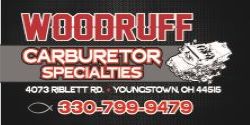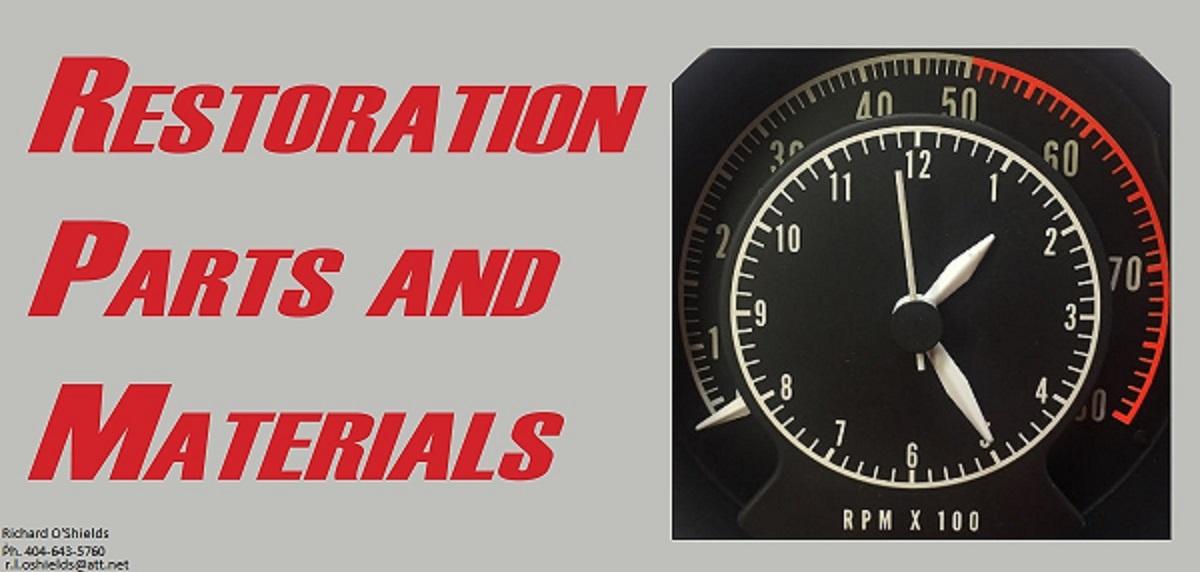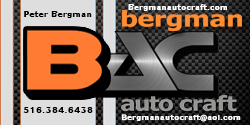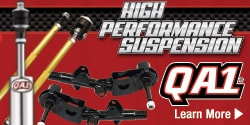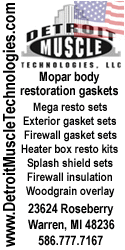Newyorker 1968 brake drum decoding
- Thread starter Affe
- Start date
@mobileparts will know
"Centrifuse" is a copyrighted process of how the metal is formed into the cast brake drum.
The other stampings are probably inspector stamps for passing certain quality control inspections and processes. Some might identify the drum for the particular width of brake shoes used in it.
I suspect that many of the people who might have known those things, when they were active in their employment functions, might not be around 50+ years later. Just a suspicion.
Vehicles have a vast amount of related stampings on their components. Some might really, openly identify the components and relate to actual parts book part numbers, but them MOST do not, from my experiences of 45+ years in dealership parts.
It might be nice to see if the brake drums were original to the car, but as consumables, knowing such if of basically zilch real value to the ultimate value of the car. It can also mean that the prior owner did not allow the drums to be cut with each brake job, too. Hard to save them from being consumed/worn as the vehicle is used.
As to C-bodies, the ONLY place where such codes really might matter could be in the Concours Judging at the Mopar Nationals. Where their 1400+ point judging sheet noted such things as if a straightened bumper showed evidence of such on its backside surface. But when I knew about that judging, no wheel was pulled to inspect the brakes.
CBODY67
The other stampings are probably inspector stamps for passing certain quality control inspections and processes. Some might identify the drum for the particular width of brake shoes used in it.
I suspect that many of the people who might have known those things, when they were active in their employment functions, might not be around 50+ years later. Just a suspicion.
Vehicles have a vast amount of related stampings on their components. Some might really, openly identify the components and relate to actual parts book part numbers, but them MOST do not, from my experiences of 45+ years in dealership parts.
It might be nice to see if the brake drums were original to the car, but as consumables, knowing such if of basically zilch real value to the ultimate value of the car. It can also mean that the prior owner did not allow the drums to be cut with each brake job, too. Hard to save them from being consumed/worn as the vehicle is used.
As to C-bodies, the ONLY place where such codes really might matter could be in the Concours Judging at the Mopar Nationals. Where their 1400+ point judging sheet noted such things as if a straightened bumper showed evidence of such on its backside surface. But when I knew about that judging, no wheel was pulled to inspect the brakes.
CBODY67
Motor Wheel | CentriFuse Brake Drums
CentriFuse brake drums set the standard for being lightweight, durable and improving fuel efficiency while reducing maintenance. Proven for more than 80 years, their steel jacket technology and precision balancing provide unparalleled performance and a smooth ride.
Seem to be truck brake drums?
See also:

Need help identifying brakes please
Hello. I have a 1968 Dart and the brakes were changed to discs and larger rear drums from the original power drums. I need help identifying what I have. The previous owner thought the brakes were from a later Dart but I do not think so. Also, the master was not changed from the original. I have...
 www.forabodiesonly.com
www.forabodiesonly.com
post #7
Thank you for the answer ."Centrifuse" is a copyrighted process of how the metal is formed into the cast brake drum.
The other stampings are probably inspector stamps for passing certain quality control inspections and processes. Some might identify the drum for the particular width of brake shoes used in it.
I suspect that many of the people who might have known those things, when they were active in their employment functions, might not be around 50+ years later. Just a suspicion.
Vehicles have a vast amount of related stampings on their components. Some might really, openly identify the components and relate to actual parts book part numbers, but them MOST do not, from my experiences of 45+ years in dealership parts.
It might be nice to see if the brake drums were original to the car, but as consumables, knowing such if of basically zilch real value to the ultimate value of the car. It can also mean that the prior owner did not allow the drums to be cut with each brake job, too. Hard to save them from being consumed/worn as the vehicle is used.
As to C-bodies, the ONLY place where such codes really might matter could be in the Concours Judging at the Mopar Nationals. Where their 1400+ point judging sheet noted such things as if a straightened bumper showed evidence of such on its backside surface. But when I knew about that judging, no wheel was pulled to inspect the brakes.
CBODY67
Thank you for the clarifying answer CBODY67. Im have always been interested in numbers , stamps and dabs and such."Centrifuse" is a copyrighted process of how the metal is formed into the cast brake drum.
The other stampings are probably inspector stamps for passing certain quality control inspections and processes. Some might identify the drum for the particular width of brake shoes used in it.
I suspect that many of the people who might have known those things, when they were active in their employment functions, might not be around 50+ years later. Just a suspicion.
Vehicles have a vast amount of related stampings on their components. Some might really, openly identify the components and relate to actual parts book part numbers, but them MOST do not, from my experiences of 45+ years in dealership parts.
It might be nice to see if the brake drums were original to the car, but as consumables, knowing such if of basically zilch real value to the ultimate value of the car. It can also mean that the prior owner did not allow the drums to be cut with each brake job, too. Hard to save them from being consumed/worn as the vehicle is used.
As to C-bodies, the ONLY place where such codes really might matter could be in the Concours Judging at the Mopar Nationals. Where their 1400+ point judging sheet noted such things as if a straightened bumper showed evidence of such on its backside surface. But when I knew about that judging, no wheel was pulled to inspect the brakes.
CBODY67
I was always interested in "numbers", too. Still am. Some numbers get to be more of a "side issue" as others have some definite ID purposes. As cylinder head and engine block casting numbers and dates. There is a "Mopar Joe" video where they detail how the same casting number can yield a different actual casting depending upon the casting date on the block. In this case the 1971 casting dates vs 1972 casting dates on 400 blocks. Things learned "on the side" from actual observations and some corroborating information from other machine shops familiar with Chrysler engines.
On about 95% of items which are cast, the item will have some ID of the part in casting numbers and such. Some sort of "calendar", as to month and shift, for example, plus a "casting number" for their internal plant use and ID. The actual OEM part number can be different, but in some cases, only a few numbers off from the casting number, by observation (on plastic parts).
Once the part is cast, if it is an interior trim piece which is ready to use as soon as the casting fluids/protectants are cleaned, it will be inspected. If it passes, it ships. If not, it gets disposed of. On a cast metal part, each part of the machining/finishing operation will have some "inspection marks" on it, plus some ID for the casting. IF it passes "final inspection", it is shipped, if not, it is discarded for further investigation to see what happend and where. In the case of the brake drum in question, the application of the "Centrifuse" stamping could be the final inspection stamp?
In so many car parts, the use of those plant stampings are just for the use of the plant people with FEW people who knew how to decode them on the outside world. In the "outside world" we were trained as to what to look for (on engine blocks and cylinder heads) in order to get what we desired. Numbers and shapes, depending upon the part and OEM.
In the 1960s, it was sometimes easy to tell an OEM brake drum from an aftermarket brake drum. Differences in the shape of the outer surface (finned or not, for example) or fins that migiht not be as numerous. But as things got more critical, the aftermarkets looked almost as if they COULD have been an OEM item. Brake drums were usually machined with each new set of brake linings installed, but many times not if there were no pedal pulsation issues. The installer could make that decision. Of course, once they were machined to the stamped-in "Max ID" spec, they were discarded into the scrap iron barrel. Quality replacements were obtained and things continued as normal.
In specific sections of the factory parts and factory service manuals, there are "INFO" sections which show how to decode engine, transmission, axle assemblies, etc as to what they are and using them to procure replacement parts for them. Plus Data Plate decodes, too (generally).
On about 95% of items which are cast, the item will have some ID of the part in casting numbers and such. Some sort of "calendar", as to month and shift, for example, plus a "casting number" for their internal plant use and ID. The actual OEM part number can be different, but in some cases, only a few numbers off from the casting number, by observation (on plastic parts).
Once the part is cast, if it is an interior trim piece which is ready to use as soon as the casting fluids/protectants are cleaned, it will be inspected. If it passes, it ships. If not, it gets disposed of. On a cast metal part, each part of the machining/finishing operation will have some "inspection marks" on it, plus some ID for the casting. IF it passes "final inspection", it is shipped, if not, it is discarded for further investigation to see what happend and where. In the case of the brake drum in question, the application of the "Centrifuse" stamping could be the final inspection stamp?
In so many car parts, the use of those plant stampings are just for the use of the plant people with FEW people who knew how to decode them on the outside world. In the "outside world" we were trained as to what to look for (on engine blocks and cylinder heads) in order to get what we desired. Numbers and shapes, depending upon the part and OEM.
In the 1960s, it was sometimes easy to tell an OEM brake drum from an aftermarket brake drum. Differences in the shape of the outer surface (finned or not, for example) or fins that migiht not be as numerous. But as things got more critical, the aftermarkets looked almost as if they COULD have been an OEM item. Brake drums were usually machined with each new set of brake linings installed, but many times not if there were no pedal pulsation issues. The installer could make that decision. Of course, once they were machined to the stamped-in "Max ID" spec, they were discarded into the scrap iron barrel. Quality replacements were obtained and things continued as normal.
In specific sections of the factory parts and factory service manuals, there are "INFO" sections which show how to decode engine, transmission, axle assemblies, etc as to what they are and using them to procure replacement parts for them. Plus Data Plate decodes, too (generally).
Similar threads
- Replies
- 3
- Views
- 338
- Replies
- 9
- Views
- 1K
- Replies
- 3
- Views
- 997
- Replies
- 10
- Views
- 1K
- Replies
- 3
- Views
- 968

